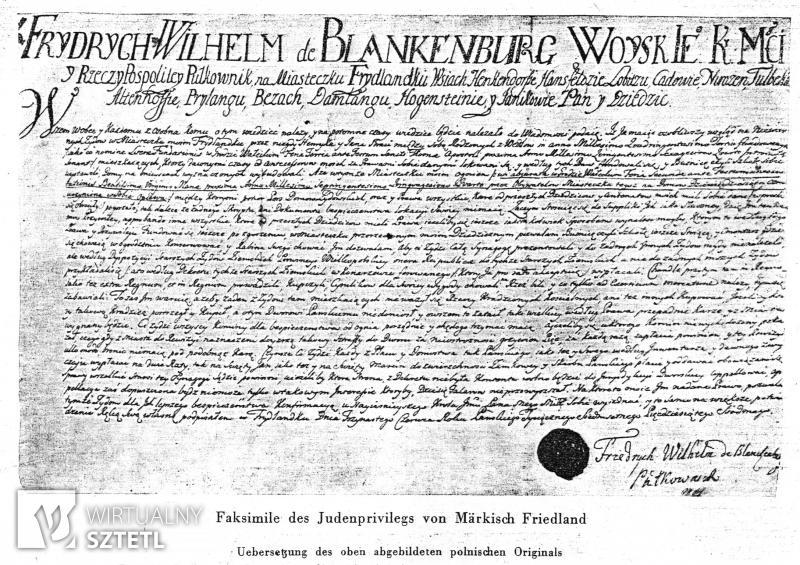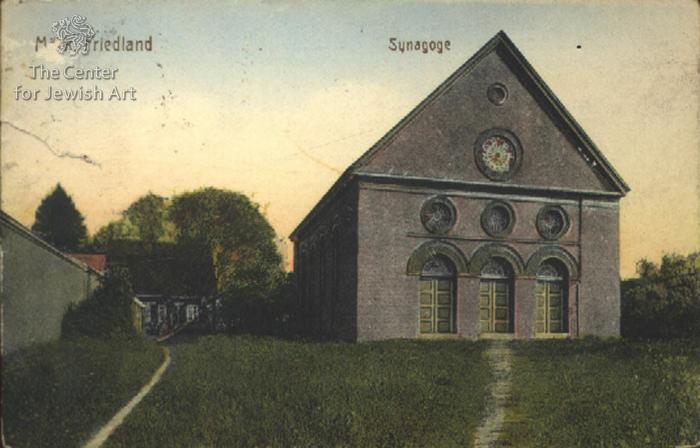The Jewish history of Märkisch Friedland
The fact that Märkisch Friedland has a much older Jewish history than does Tiegenhof leads me to believe that the Paechter family originated in Friedland and later some of them resettled farther east.
Here is a translation of a page on deutsch-krone.com that gives some of the town's history, dating back to the 1500s.
The place probably received city rights in 1303, which the von Wedell brothers had renewed in 1314. In 1368 the city fell to Poland and in 1409 an army of the order occupied Märkisch Friedland. In 1466 it fell again to Poland.
In 1543 the estate and the entire town converted to Protestantism and the von Blankenburg family took over the town in 1581. This began a larger influx of Jews, as Heinrich von Blankenburg accepted them as welcome taxpayers because of their protection money.
A major city fire in 1719 destroyed the church, school and the landlord's castle. In 1758 Märkisch Friedland was again destroyed by flames, almost the entire town burned down. It was then almost entirely rebuilt with two-story houses.
In the 19th century, a lot of Jews - around half of the population - emigrated to Berlin.
In 1900 the connection to the railway network, the Kallies - Falkenberg route, took place. At that time the town had two dye works, two mills, six slaughterhouses, a beer brewery, a machine building factory, a soap factory, a groats factory and a spirit distillery. Some historical photos can be found in the gallery .
Jewish community
In Friedland, Jews immigrated from Brandenburg, specifically from Nörenberg in Pomerania, in the 16th century as a result of the persecutions and expulsions of 1510 and 1573. At its peak in the 18th century, the community that was then founded had 247 families with around 1,400 residents.
The Jewish cemetery was founded in the 17th century. Its area is approximately 2.2 hectares. It is the oldest Jewish cemetery in Pomerania. It is still relatively well preserved today, even if it is completely overgrown with bushes. A synagogue was built at the Mühlentor in 1770.
At the beginning of the 18th century, the Jewish community had its own four-class school, which was still in existence even in 1819, when many Jews had already moved to Berlin. In 1819 there were still 3 Jewish and 1 Christian teachers teaching there.
In Märkisch Friedland, the affairs of the Jewish community from 1791 - 1815 were led by Rabbi Akiba EGER, who later became chief rabbi of Posen and head of the theological training center "Jashiwa".
The Märkisch Friedlander Jewish community gained particular importance as the "mater" of Berlin Jewry; many Jews from Märkisch Friedland emigrated to Berlin in the 19th century, which led to the accumulation of the surname "Friedländer" there.
The final decline of the Jewish community took place during the Nazi era.
Many Jews had to sell their belongings and leave the city. The remaining Jews were deported to the Sachsenhausen concentration camp in January 1939. Many Märkisch Friedland Jews were murdered in Auschwitz and Theresienstadt. A list about the fate of Jewish fellow citizens who were born or lived in Märkisch Friedland compiled from the Yad Vashem database. It provides information about the fate of 67 Märkisch Friedland Jews.
The reference to Nörenburg and the 1573 expulsion is especially interesting. Today, Nörenurg is the town of Insko, about 30 miles northwest of Miroslawiec.
It seems our Paechters could go far back in Friedland, as opposed to in Tiegenhof, where the earliest Jews arrived in the 18th century.


